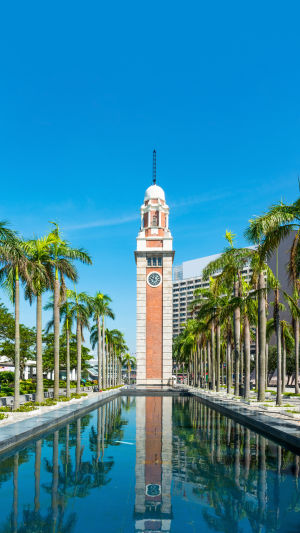If you’ve ever visited Hong Kong’s Tsim Sha Tsui, you’ve probably noticed the iconic Clock Tower towering over the waterfront, proudly standing at 44 meters tall. But why is this clock such a prominent symbol?
Well, this historic landmark, which was once part of the Kowloon-Canton Railway terminus, has a rich history that spans over a century. So, let’s wind back the hands of time and take a closer look at the reasons behind the Clock Tower’s construction and its journey to becoming a cherished monument.
<h3>A Monument of Transition: The Railway Connection</h3>
The Tsim Sha Tsui Clock Tower was built in 1915 as part of the Kowloon-Canton Railway (KCR) terminal. Hong Kong was interconnected with Britain at the time, and the railway was vital for connecting Hong Kong with mainland China. The tower was initially constructed as a way to help travelers keep track of time before catching their trains. Although the station was eventually demolished in 1977, the tower remained, offering a symbolic link to Hong Kong’s past.
<h3>The Design: A Blend of Beauty and Practicality</h3>
Standing tall and proud, the Clock Tower is made of red brick and granite, a design that reflects the British style of the time. Its construction wasn’t just about being a functional timepiece; it was also about creating a landmark. Designed by British architects, the tower’s appearance is elegant yet sturdy, making it a fitting monument in the bustling cityscape. In fact, the design is so remarkable that it has become one of the most photographed sites in Hong Kong.
[4K] HONGKONG Tsim Tsa Tsui Clock Tower | Waterfront View | walk tour 2021
LIBRA buddy
<h3>The Clock Tower Survives the 20th Century</h3>
When the events of 1939 came knocking, the Clock Tower wasn’t spared from the chaos. During the Japanese occupation of Hong Kong, the bell stopped ringing, and the tower was painted in camouflage to blend in with the surroundings. The building sustained some damage, but miraculously, it stood strong. After, the clock was restored and the bell was reactivated in 1945. However, due to mechanical issues, the bell eventually stopped chiming, and by the 1950s, it was retired for good.
<h3>A Monument in Peril: The Fate of the Station</h3>
By the early 1970s, the Kowloon-Canton Railway was no longer operating in its original location. The old terminal, along with most of its surrounding infrastructure, was demolished to make way for new developments. Thankfully, the Clock Tower was preserved, much to the relief of heritage groups who campaigned to save it. In 1990, it was officially gazetted as a declared monument, ensuring that it would remain a part of Hong Kong’s skyline for years to come.
<h3>A Modern-Day Icon: The Clock Tower’s Role Today</h3>
Today, the Tsim Sha Tsui Clock Tower is not just a relic of the past - it’s a symbol of Hong Kong’s dynamic history. Positioned at the tip of the Tsim Sha Tsui Promenade, it offers a perfect spot for photos with Victoria Harbour in the background. The tower also serves as a reminder of the city’s British heritage and its transformation into a modern metropolis. Now, with the bell chimes once again ringing every hour, it’s hard not to stop and admire this architectural gem.
If you’re planning a trip to Hong Kong, the Tsim Sha Tsui Clock Tower should definitely be on your list of places to visit. Not only does it offer a glimpse into the past, but it also provides a beautiful setting for photos and a peaceful moment by the waterfront. Just remember, while you’re snapping your pictures, take a moment to breath in the tower’s significance and how it survived the test of time.





